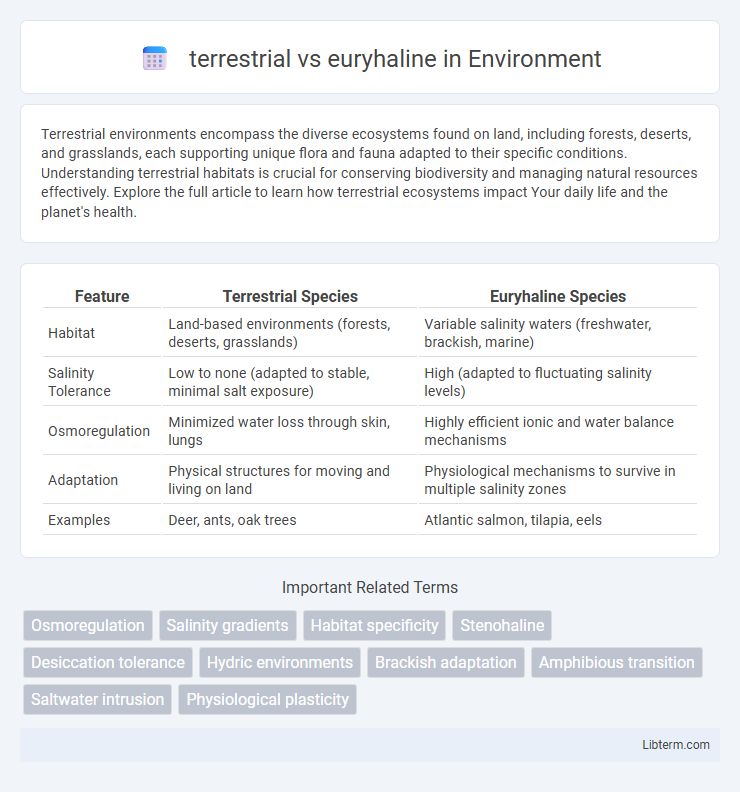Terrestrial environments encompass the diverse ecosystems found on land, including forests, deserts, and grasslands, each supporting unique flora and fauna adapted to their specific conditions. Understanding terrestrial habitats is crucial for conserving biodiversity and managing natural resources effectively. Explore the full article to learn how terrestrial ecosystems impact Your daily life and the planet's health.
Table of Comparison
| Feature | Terrestrial Species | Euryhaline Species |
|---|---|---|
| Habitat | Land-based environments (forests, deserts, grasslands) | Variable salinity waters (freshwater, brackish, marine) |
| Salinity Tolerance | Low to none (adapted to stable, minimal salt exposure) | High (adapted to fluctuating salinity levels) |
| Osmoregulation | Minimized water loss through skin, lungs | Highly efficient ionic and water balance mechanisms |
| Adaptation | Physical structures for moving and living on land | Physiological mechanisms to survive in multiple salinity zones |
| Examples | Deer, ants, oak trees | Atlantic salmon, tilapia, eels |
Understanding Terrestrial and Euryhaline Organisms
Terrestrial organisms are adapted to live exclusively on land, possessing physiological traits that allow them to conserve water and withstand varying temperatures. Euryhaline organisms thrive in environments with fluctuating salinity levels, such as estuaries, due to their ability to regulate internal salt concentrations effectively. Understanding these adaptations helps clarify how species survive and reproduce in diverse habitats with different environmental stresses.
Key Habitat Differences: Land vs. Variable Salinity
Terrestrial organisms primarily inhabit land environments with stable moisture and salinity levels, relying on adaptations to prevent desiccation and tolerate temperature fluctuations. Euryhaline species thrive in habitats with variable salinity, such as estuaries, tidal zones, and brackish waters, where they regulate internal salt concentrations to survive rapid changes in salinity. The key habitat difference lies in terrestrial species' adaptation to constant salinity absence versus euryhaline organisms' ability to withstand wide salinity gradients.
Adaptations for Survival: Terrestrial Strategies
Terrestrial animals exhibit adaptations such as waterproof skin, efficient water retention mechanisms, and behavioral strategies like burrowing to minimize dehydration and temperature extremes. Their respiratory systems are optimized for air breathing, employing lungs with large surface areas to maximize oxygen intake. Structural modifications, including sturdy limbs and specialized excretory systems, enable survival in variable terrestrial environments by conserving water and maintaining homeostasis.
Euryhaline Adaptations: Thriving in Changing Environments
Euryhaline species possess specialized osmoregulatory adaptations that enable them to survive in fluctuating salinity levels, such as migrating between freshwater and marine environments. They regulate ion transport through specialized gill cells and kidney functions to maintain homeostasis despite external salinity changes. These adaptive mechanisms provide resilience against habitat variability, allowing euryhaline organisms to exploit diverse ecological niches compared to strictly terrestrial species.
Water Regulation Mechanisms Compared
Terrestrial animals regulate water balance primarily through efficient kidney function that minimizes water loss by producing concentrated urine and via behavioral adaptations such as seeking shade or burrowing to reduce evaporation. Euryhaline species, capable of surviving in both freshwater and marine environments, employ dynamic osmoregulatory mechanisms including specialized gill ion transporters, variable urine dilution, and active salt secretion or uptake to maintain osmotic homeostasis. These water regulation strategies highlight evolutionary adaptations for conserving or expelling water depending on environmental salinity gradients.
Physiological Challenges Faced
Terrestrial organisms confront dehydration risks and must regulate water loss through adaptations like impermeable skin or specialized excretory systems. Euryhaline species face osmotic stress caused by fluctuating salinity levels, requiring efficient ion transport mechanisms and osmoregulatory organs such as kidneys and gills. Both types exhibit physiological adjustments to maintain homeostasis under challenging environmental conditions.
Evolutionary Pathways and Divergence
Terrestrial species evolved through adaptation to stable freshwater and dry land environments, exhibiting physiological traits optimized for water conservation and respiration in air. Euryhaline organisms developed unique osmoregulatory mechanisms enabling survival across varying salinity levels, reflecting evolutionary pathways shaped by fluctuating aquatic habitats. Divergence between these groups highlights genetic and morphological modifications driven by contrasting selective pressures in terrestrial versus brackish and marine ecosystems.
Biodiversity and Ecological Impact
Terrestrial species contribute significantly to global biodiversity by inhabiting diverse land ecosystems, supporting complex food webs, and regulating nutrient cycles. Euryhaline species enhance ecological resilience by adapting to varying salinity levels in estuarine and coastal habitats, promoting habitat connectivity and sustaining fish populations. The interplay between terrestrial and euryhaline organisms influences ecosystem stability, biodiversity conservation, and the health of both freshwater and marine environments.
Examples of Terrestrial and Euryhaline Species
Terrestrial species such as elephants, wolves, and oak trees are adapted to live exclusively on land, thriving in environments with stable freshwater and air conditions. Euryhaline species like the Atlantic salmon, bull shark, and mangrove rivulus can tolerate a wide range of salinities, enabling them to inhabit both freshwater and marine ecosystems. These adaptations allow terrestrial species to exploit terrestrial niches, while euryhaline species benefit from ecological versatility across salinity gradients.
Future Perspectives in Environmental Change
Terrestrial species face increasing challenges due to habitat loss and climate-induced shifts in temperature and precipitation, demanding adaptive strategies for survival. Euryhaline organisms, capable of tolerating a wide range of salinities, exhibit potential resilience to fluctuating aquatic environments caused by rising sea levels and freshwater influx changes. Future research emphasizes the genetic and physiological mechanisms underlying adaptability in both groups to enhance conservation efforts amid accelerating environmental change.
terrestrial Infographic

 libterm.com
libterm.com